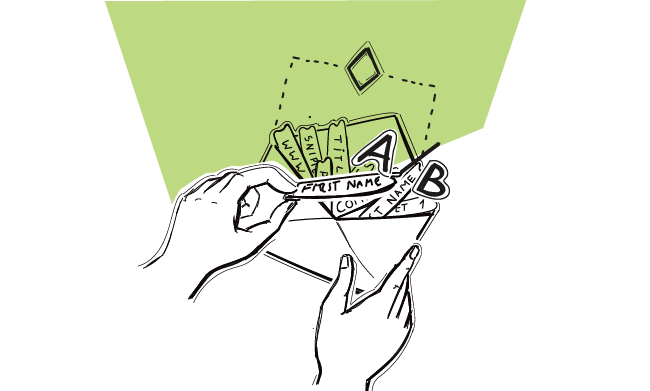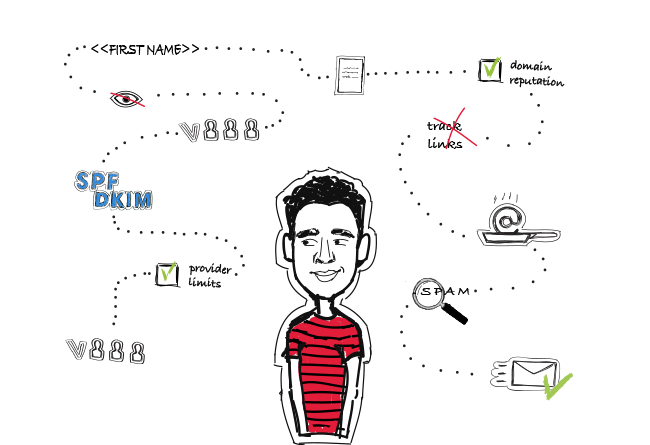That’s the question every business owner and salesperson asks themselves: how do I get more quality customers? Usually, generating new business opportunities takes a lot of time an effort.
We want to give you some tips and tricks that will allow you to add outbound to your customer sources, or improve the outbound process you’ve started.
What to do to get more clients and sell more to your current ones? Here is how to achieve that using cold email.
How to get customers with cold email
Cold email may be a very useful tactic if you are looking for new customers. Why?
It’s easy – all you need is a warmed-up email address, a bunch of contacts and lots of creativity.
It doesn’t require a huge budget to start.
It allows you to pick the clients you want to work with, not the other way round.
It’s scalable – once you crack the process and fit it into your business, you can easily scale the outreach.
If you want to succeed in outbound, you need to:
- define your ideal customer profile,
- learn about your target group and their needs,
- create a good cold email campaign, which will allow you to get their attention,
- make sure you’ve prepared your email technically for the outbound outreach and
- use a good sending system dedicated to outbound that takes care of high deliverability rates.
Step 1: Define who you want to target
The first step, before you even sit to write your first email, is to figure out who you should write to in the first place. What industry are they in? What kind of business are they running? What is their role in the business? Answer those, and a couple more, questions to create a profile of your ideal customer.
Here’s a guide on how to do that step by step.
Step 2: Do some research
Once you know who you want to reach out to, it’s time to get to know them better. What do they talk about? What are their goals? What are their most nagging problems? Those are the things you’re going to refer to in the copy of your email. Find them on LinkedIn, find them in Facebook groups or Instagram messages, find them among your friends. And do some reading and talking before you tackle the writing part. Then, collect the contacts in a spreadsheet, or use a prospecting tool to help you find the right contact details. It’s not about thousands of random contacts. It’s about 100 good ones.
Step 3: Write customer-centric email copy
Now’s the part you’ve been waiting for. There are some rules to follow when writing cold emails. These are not newsletters. They are not official announcements. And they are not commercials! Cold email is like an email to a friend – light, casual, short, interesting. Professional, yet not dull. Intriguing, asking a question that’ll make them want to reply.
Here’s the structure of a cold email to help you out here: How to Write a Cold Email that Actually Works in 6 Steps>>
Here’s why one email is not enough: How to Send a Follow-up Email After No Response>>
Step 4: Get yourself an outbound domain and mailboxes
A good practice is to have a separate email domain for sending cold emails. Here’s why: Why We Set up a Separate Mailbox for Outbound Campaigns>>
Step 5: Use Woodpecker to automate the sending in a safe way
To spend 30 minutes getting the outreach going instead of 30 days, you can use an automation tool. Woodpecker is like an email client with functions designed for cold emailing. You connect your email, and Woodpecker sends the emails and follow-ups for you. It detects replies, so you start talking when someone’s interested. That’s how you generate new leads automatically.
You can warm up your outbound domain and mailboxes for free. And that’s a good step for starters. That would be a “Step 0” in the whole sequence described above. Turn the warm-up process on, and get to the homework. Once you’re done and ready to write your emails – your outbound email accounts warmed up.
What about cold emailing some customers you used to work with?
You can also set up a campaign to some of the businesses that were using your service in the past. That makes the process of finding the right contacts much easier. You already have the names, the business types and the problems figured out. Your own mailbox may be a great source of leads.
Focus on getting back to the relationship instead of selling to them right away. Give them some value in every email:
- a fact from their recent history you may ask about
- an interesting piece of content you’ve found
- a contact you may introduce to them to bring them some value, etc.
Prepare a campaign in Woodpecker with a bunch of follow-ups. Wait for responses to come.
FAQ: Mastering Cold Email Outreach with the Right Tools
How can I test a cold email outreach tool before purchasing?
Look for cold email tools that offer a free trial. This allows you to explore their features and usability to ensure they meet your cold email marketing needs without any upfront investment.
What distinguishes cold email marketing software from other marketing tools?
Cold email marketing software is specifically designed for sending personalized cold emails at scale, with features like mail merge, email tracking, and automated follow-ups, making it more suited for direct email outreach campaigns.
How do I choose the best cold email software for my sales engagement platform?
The best cold email software integrates seamlessly with your sales engagement platform, offering features like multi-channel outreach, custom domain tracking, and B testing to enhance your sales process and improve sender reputation.
Can cold email tools improve my sales team’s efficiency?
Yes, cold email tools can significantly boost your sales team’s efficiency by automating follow-ups, providing email tracking for insights into engagement, and allowing for personalized email campaigns, freeing up time for more strategic tasks.
What features should I look for in cold email outreach software?
Essential features include automated follow-ups, personalized cold email campaigns, unlimited email accounts, and email tracking. Advanced options like custom domain tracking and multi-channel outreach are also valuable for a comprehensive sales engagement strategy.
How does a cold email platform benefit my sales process?
A cold email platform streamlines your sales process by enabling you to manage cold email campaigns efficiently, track engagement, and automate follow-ups, ensuring consistent outreach and nurturing of leads.
Is there a cost-effective way to scale cold email outreach campaigns for my sales team?
Yes, look for cold email outreach tools that offer pricing “per user” or “per month” with scalable features like unlimited email accounts and mail merge. This allows you to adjust your investment based on your team’s size and outreach volume.
How can cold emailing software impact my sender reputation?
High-quality cold emailing software includes features to manage your sender reputation, such as email validation, automated warm-up campaigns, and spam filter avoidance techniques, ensuring your emails reach the inbox.
What advantages do personalized cold emails offer over cold calling?
Personalized cold emails allow for targeted, thoughtful communication that recipients can engage with at their convenience, unlike cold calling, which can be intrusive and untimely. Email also provides the space to convey more detailed information and resources.
How can I ensure my email campaigns are effective across multiple channels?
Utilize cold email marketing tools that support multi-channel outreach, allowing you to coordinate email campaigns with other channels like social media or phone calls, ensuring a cohesive and consistent message across all touchpoints.
READ ALSO

10 Golden Rules of Cold Email
Writing a cold email is easy. That’s what people think – I mean the people who never tried writing one. It’s not easy for many reasons, but especially because we have to remember about so many things at once while writing it. Actually, we have to remember about at least 10 things. I call them the Golden Rules of Cold Email. Whether you're sending cold email for some time now, or you're just starting and have never sent your first cold email campaign yet, you should know them by heart. Here they are.

14 Deliverability Checks to Carry Out Before Sending Your Cold Email Campaign
You can have control over your cold email deliverability. In outbound outreach, it's crucial how many of the emails you sent actually get to your prospects' inboxes. There are at least 14 points on a deliverability checklist that you can, and should, go through before you start off your email campaign. I've listed them below in three categories. Some of them you may already know of, but some may be new for you. Check the list and see if you're doing everything you can to ensure that your cold emails actually get to their destination.

9 Resources that Help Learn Quality Cold Emailing [Updated]
Quality cold emailing is a skill to be learned. It cannot be learned overnight. It takes months and years to learn how to write and send cold emails that work. And the learning never stops, really. It's a process of constant improvement. And during the process, you constantly look for guidance, inspiration, and advice based on experience. Below, I'm sharing with you my list of 9 cold emailing resources including books, ebooks, blogs, and a YouTube channel that are helping me in my learning process.
